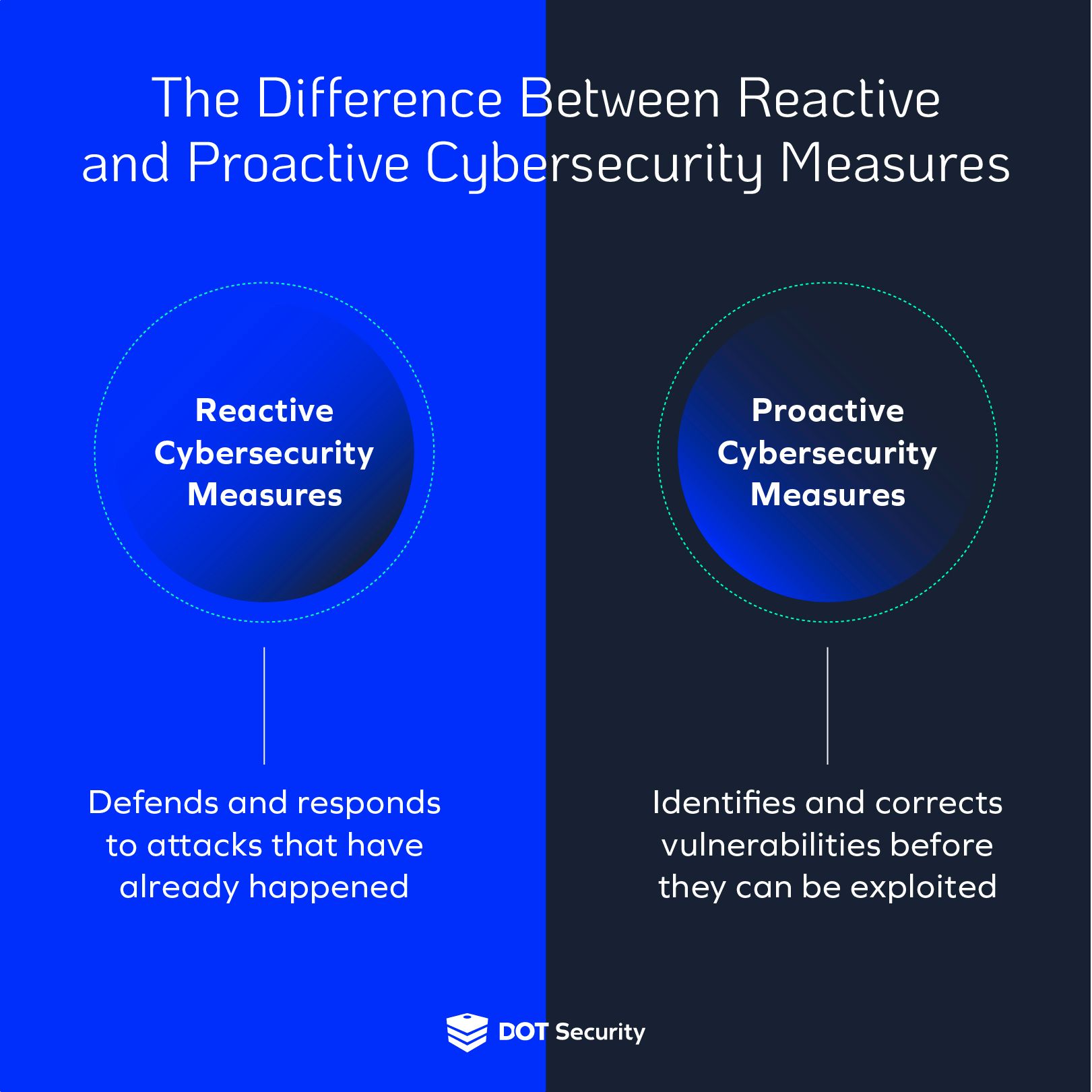Network Security Monitoring
Implementing Proactive Cybersecurity Measures vs. Reactive Tactics
October 10, 2025
7 minute read

When driving on a busy highway, you need to be ready to react at a moment’s notice to stay safe. However, to give yourself even better odds at avoiding an incident, you can practice proactive defensive driving. When it comes to cybersecurity, a proactive strategy helps prevent threats from blossoming while reactive tactics address security concerns in real-time.
Proactive cybersecurity strategies defend your systems before an attack occurs. They are often considered the first line of in defense because they prevent threats from infiltrating and maturing in your environment.
Sign up for our newsletter!
Join us below to gain a more comprehensive understanding of proactive cybersecurity measures, how they differ from reactive cybersecurity tactics, and an inside look at the tools, software, and policies that create a more proactive strategy.
Learn what you need to build a strong defense and start protecting your business from modern cyberthreats with DOT Security’s Cybersecurity Checklist: How Covered is Your Business? Download the checklist now and get started.
Proactive Cybersecurity Measures vs. Reactive Cybersecurity Tactics
Proactive cybersecurity measures are steps taken by technology experts within a business to prevent incoming attacks. This includes a number of tactics such as implementing technology to identify threats before they penetrate your network, monitoring your systems 24/7, keeping your software fully updated, and implementing a culture of security across your entire organization.

Proactivity in cybersecurity is more than just plugging in software. It’s a mindset, culture, and dedication to consistent security audits that help you understand the possible threats and vulnerabilities organization-wide.
Reactive cybersecurity measures, on the other hand, are built only to respond to attacks after they’ve already begun. This means patching vulnerabilities after they’ve been exposed and abused, updating firewalls and antivirus software after it’s already been breached, and taking measures to prevent repeat attacks.
Incident detection and response, which dictates the protocols your organization follows in the event that a cyber breach occurs, is a major pillar in reactive cybersecurity. Incident detection and response is mainly focused on identifying, isolating, and neutralizing active threats in the environment, rather than preventing future threats.
Incident response plans are typically created and run by your cybersecurity team or partner through a hypothetical round-table during which a cyberattack is played out, and the reality of your strategy can be cemented.
Drawbacks of a Reactive Cybersecurity Strategy
A solely reactive approach to cybersecurity puts you at a disadvantage because, while it allows you to remediate cyber incidents, reactive tactics are only helpful after a cyberattack is successful. This emphasizes how important it is to blend proactive cybersecurity measures with reactive tactics so you can halt cyberattacks before they infiltrate your systems.
Other drawbacks that stem from a solely reactive approach to cybersecurity include:
-
Increased Security-Related Costs: It costs more money to stop breaches after they occur than to invest in the technology used to potentially prevent them. Post-breach, businesses are susceptible to costs like government fines, ransoms, and the costs associated with recovery (not to mention the impact of losing the trust of your customers).
-
Ineffective Damage Control: Proactive cybersecurity controls provide a baseline for a business’ cybersecurity system. This means that, when a breach occurs, businesses without proactive cybersecurity measures may find themselves unable to combat the threat because their security foundation is so weak.
-
Non-Compliance: Most major data security regulations require proactive cybersecurity measures. Without them, you could find yourself immediately non-compliant and risk facing the consequences, oftentimes fines.
-
Unaddressed Vulnerabilities: One proactive cybersecurity measure is managing regular system updates across systems. If you aren’t establishing proactive cybersecurity measures, important security updates may be left uninstalled, opening up additional vulnerabilities that could be targeted.
Reactive cybersecurity measures alone give you much less control and visibility over your network security, leaving you to try and catch up to cybercriminals.
Rather than relying on reactive tactics to address cyber incidents after they’ve been launched against your network, modern organizations should look to a layered approach that blends proactive cybersecurity strategies with reactive remediation tactics.
With cyberattacks becoming ever more sophisticated and organizations both generating and storing more data than ever before, addressing comprehensive cybersecurity is a necessity for modern organizations.
This is especially the case as more and more businesses are going to start using cybersecurity maturity as a major consideration in choosing partnerships and the cybersecurity insurance industry continues to grow.
Combining a Proactive Cybersecurity Strategy With Practical Tactics
Proactive cybersecurity measures give you more visibility and a better chance of preventing cyberattacks from succeeding in the first place. However, in the event a cyberattack does occur, as mentioned earlier, it will be crucial that your cybersecurity team has a plan of action that they’re ready to execute.
On the other side of the coin are proactive cybersecurity measures that strengthen network security and prevent cyber incidents in the first place. For example, network segmentation is something you can do outside the context of a cyberattack that greatly reduces the damage that can be done in the event that any one user’s account is compromised.
As such, proactive cybersecurity measures should act as the foundation of your strategy. Let’s take a closer look at proactive cybersecurity as a whole.
Proactive Cybersecurity Measures
When it comes to those proactive security measures, they come in a lot of varieties that secure different vulnerabilities across your network and neutralize a spectrum of cyber threats.

Here are a few examples of proactive cybersecurity measures that modern businesses use to stay secure:
- Employee Awareness Training: People are often your first line of defense. It’s critical that you give them the training they need to be aware of and resist common threats. Cybercriminals tend to view people as a weak point in business security, but with the right training, they don’t have to be.
- Updated Next-Gen Antivirus (NGAV): Legacy antivirus software doesn’t cut it anymore because not only has it been figured out by cybercriminals but it also lacks the features that are required for proactive cybersecurity. NGAV, though, will keep your systems safe against modern, sophisticated cyberattacks with native AI models that combat even the most sophisticated viruses.
- Software Patches and Updates: When developers become aware of vulnerabilities in software, they release patches to secure them. For businesses, it’s important to keep all your software fully updated with the latest patches to keep cybercriminals from abusing these known weaknesses. Some of these might download and install automatically, but it’s vital to monitor for regular updates so you don’t open yourself up to additional vulnerabilities.
- Firewalls: Similarly to antivirus software, businesses need new-school firewalls that can recognize and filter out modern threats. Firewalls create a controlled channel for the transfer of information across a website. Next-generataion firewalls include antivirus and malware protections that automatically update whenever a new threat is identified.
- Data Encryption: Encrypting data helps businesses keep it secure, even if it does fall into the wrong hands, by ensuring only those with access can decipher it.
- Data Segmentation: If an attack occurs, data segmentation is a proactive cybersecurity measure that businesses can take to prevent cybercriminals from accessing everything through a single vulnerability.
- Network Monitoring: Modern network monitoring solutions can implement AI and machine learning technology to adapt and learn about new threats and how to spot them. This ability helps protect businesses from evolving threats.
- Identity and Access Controls: It’s important to restrict access to important systems and information to those that absolutely need it to do their jobs. Enforcing the principle of least privilege is a step that businesses can take to ensure nobody is misusing credentials to access information they shouldn't creating additional vulnerabilities.
- Endpoint Protection and Edge Security: It’s important to cover all your angles when fighting cybercriminals. Edge security and endpoint security services provide additional layers of security by protecting your business from being compromised by smart devices on the fringe of your network.
Staying Informed and Educated
A proactive cybersecurity strategy hinges on continuous learning. Threats evolve rapidly as new vulnerabilities, attack vectors, and defense mechanisms emerge almost daily. Staying informed isn’t just a best practice; it’s a necessity.
Cybersecurity professionals and organizations that prioritize education are better equipped to anticipate risks before they escalate. This means:
- Monitoring trusted cybersecurity news sources for updates on emerging threats and industry trends.
- Participating in ongoing training and certifications to stay sharp and compliant with evolving standards.
- Engaging with professional communities to exchange insights and learn from real-world incidents.
Reactive tactics often stem from a lack of awareness. By contrast, proactive teams build resilience through knowledge—transforming potential surprises into manageable scenarios.
Beyond individual learning, fostering a culture of cybersecurity awareness across an organization is equally vital. When employees at every level understand the basics of cyber hygiene and recognize common threat indicators, they become active participants in the company’s defense posture.
Regular internal workshops, phishing simulations, and digestible updates on policy changes can empower teams to act decisively and prevent breaches before they occur.
Wrapping up on Proactive Cybersecurity Measures vs. Reactive Tactics
When thinking about proactive cybersecurity and reactive tactics, it can help to think about the offense and defense of your favorite sports team. In a way, proactive cybersecurity measures are the offense, hunting for threats to stop before they land in the network, and the reactive tactics are the defense, neutralizing threats that manage to infiltrate your network to minimize the damage they do.
Implementing proactive cybersecurity measures is the best way to stay ahead of modern cyberattacks and prepare your business for anything that can be thrown its way. With a comprehensive cybersecurity strategy that focuses on combining proactive tools with reactive remediation tactics, your organization can stay secure in a constantly evolving digital world.
Start taking a more proactive approach to your business’ cybersecurity today. Use DOT Security’s Cybersecurity Checklist: How Covered is Your Business? to see what your business needs to build a strong defense and stay protected from evolving cyberthreats.
